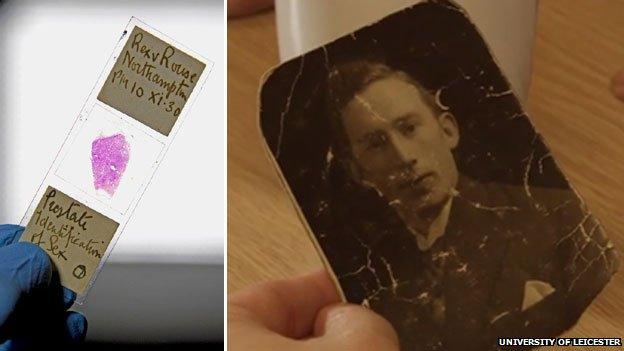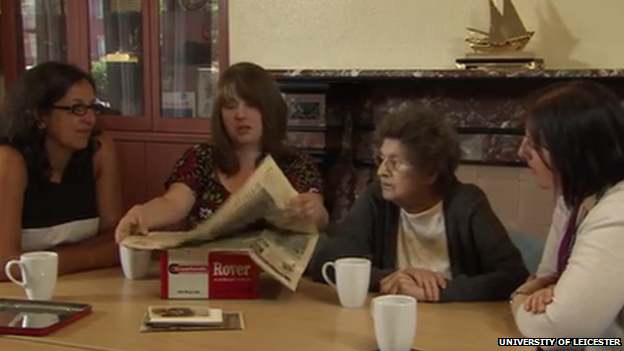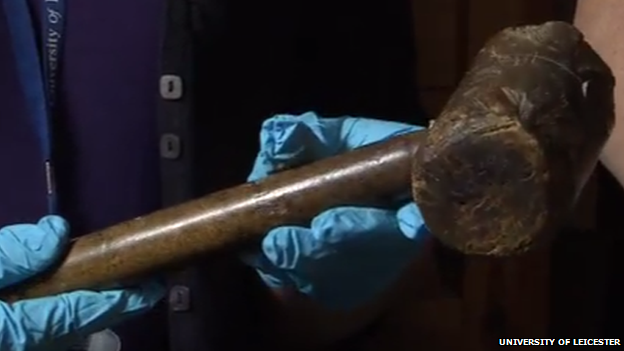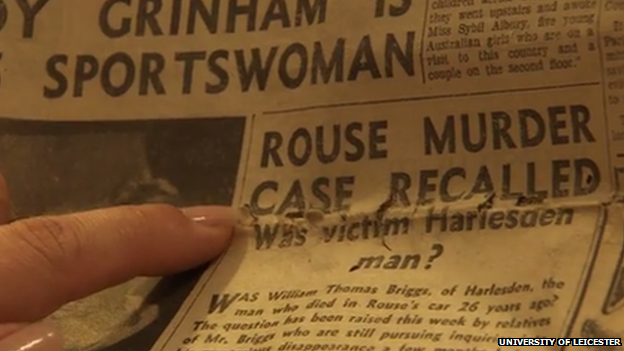Northamptonshire blazing car murder: Family gets DNA result
- Published

Scientists compared the DNA of the 1930 murder victim to that of the family of William Thomas Briggs
A family who feared for more than 80 years that their relative was murdered have been told by scientists the victim's DNA does not match theirs.
The victim of the "blazing car murder" has remained a mystery since 1930, when Alfred Rouse burned a man to death in his Morris Minor in Northamptonshire.
The family of William Thomas Briggs had believed he may have died in the car.
The University of Leicester found the victim's DNA on archived material. It did not match that of the family.
However, the team said they were still hopeful of a breakthrough and believe the "fantastic" find of a single, uncontaminated DNA profile on a 1930 microscope slide could lead to success in other unsolved cases.
Doctor's appointment
Philanderer Rouse, 36, attempted to fake his own death by hitting a man over the head, placing him in his car and setting it alight.
He chose the village of Hardingstone, near Northampton, in the early hours of 6 November, 1930 - a night when he believed a large fire would go unnoticed.
But two witnesses saw him running away from the blaze, a leather case in hand, and went to investigate.
Rouse was hanged at Bedford Jail, taking the identity of the unknown man to the grave.

The family of William Thomas Briggs, including Samantha Hall (second left), hoped to find an answer

The mallet Alfred Rouse used on his victim is still held in the Northamptonshire Police archive

The Briggs family had pushed for a reopening of the case more than 20 years after William's disappearance
In the years since, Mr Briggs' family had reason to believe the 23-year-old may have been the pawn in Rouse's plan, but had no way of proving it beyond doubt.
In 1930, factory worker Mr Briggs, who worked as a packer for Osram Lamps, had left the family home in Harlesden, north-west London, for a doctor's appointment but did not arrive at the surgery and was never seen again.
Crucially, he was of similar height and build to Rouse and, like the murderer, had auburn hair - a good fit for a man hoping to convince others he had died in a car fire.
Recently, Mr Briggs' great-great niece, Samantha Hall, contacted police in the hope DNA profiling may finally provide answers.
Family keepsakes
Describing Mr Briggs' disappearance, Ms Hall said: "He was dressed in a plum suit and turned to wave his mum goodbye from the doorstep and but he was never seen again.
"Auburn hair was found at the crime scene, and a patch of plum cloth.
"All of these stories have been passed down the generations and it's only recently I've been through the family keepsakes and found newspaper clippings and letters that my great-aunts had written, trying to reopen the murder case.
"Getting the answer to this would mean closure for my family."
Northamptonshire Police put the family in touch with the University of Leicester.
The team looked at the Rouse murder file, which contained the large wooden mallet he had used to first attack the victim, and a box of debris from the fire.
Tissue samples from the victim's prostate and lung had been extracted by Home Office pathologist Sir Bernard Spilsbury, whose entire work is held at the Royal London Hospital archive.
With the samples more than 80 years old, the team feared the tissues may have been contaminated with other people's DNA, or would be damaged when the glass side was removed.
But forensic scientists at Northumbria University were able to extract the tissue, analyse it and find a single DNA profile.
This was compared to that of Ms Hall and her relatives, and was found not to match.
'Exciting first step'
In a statement, the family said they were thankful for all the work carried out, and relieved to know Mr Briggs had not suffered a horrific death at the hands of Rouse.
They now accept that they will probably never know what happened to him and why he never came back that day.
Dr John Bond, senior lecturer in forensic science at the University of Leicester, said the investigation was still useful.
"From a scientific perspective it is fantastic that we have been able to obtain DNA from a microscope slide over 80 years old," he said.
"There is still the possibility of identifying the victim if other families with a relative who went missing around November 1930 can be traced.
"The fact we have obtained a profile from this slide also opens the door for other cases to be tested in a similar way."
Det Ch Supt Paul Phillips, of Northamptonshire Police, said it could be an "exciting first step towards the mystery being solved".
- Published20 January 2014
- Published20 January 2014
- Published14 January 2014
- Published3 May 2012